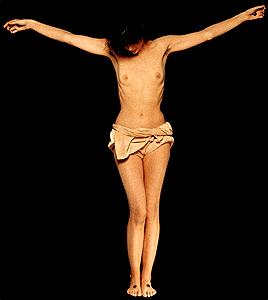
beautyme collections culture cuisine motor music search
 I.N.R.I.
I.N.R.I.PHOTOS/FOTOGRAFIEN
BETTINA RHEIMS / SERGE BRAMLY
Eine Ausstellung mit Neuerwerbungen der Sammlung Essl
20.04. - 02.07.2000
Bettina Rheims' and Serge Bramly's photo series entitled I.N.R.I. was prompted by the idea of a latter-day Jesus and the salvation he had to offer. The French photographer and Bramly, a writer and philosopher, enacted their present-day version of gospels over the course of several years. They drew their protagonists for the figures in the Holy Scriptures from amongst actors and models, but also from the streets of Paris and Majorca. Eventually, 200 people were then chosen from a total of 1,500 to present the most important stations in Jesus' life. As a child Jesus plays on an abandoned industrial site, the Savior on the cross is a young woman and the twelve apostles - young men in jeans, leather jackets and sneakers - meet at a dilapidated railway siding. The scenes for these enactments, which were planned down to the last detail, were set on Palma de Mallorca and at the disused Cochin psychiatric clinic on the outskirts of Paris. "The walls tell of pain, agony and despair. ... Where would Christ appear to us today? Undoubtedly not in the elegant town centers of Vienna or Salzburg but out there in the slums of major cities, amongst the homeless and AIDS victims..." (Bettina Rheims). With the aid of simple, easily understood symbols and inspired by folk art and the aesthetics of advertising and fashion photography that imbues Rheims' work, the photographer and the philosopher transform their "history of history" into a colorful, shrill world of video clips, combined with quotations from art history. "We didn't and do not want to hurt religious feelings, but rather to thwart viewing habits. Many classical artists were presented with the same problem in their times, when they tried to implement a new pictorial language." (Bettina Rheims)
In I.N.R.I. Bettina Rheims and Serge Bramly have created one their most significant series of works. The Essl Collection will be presenting key works from this series, which were purchased for the collection, in the exhibition.
Bettina Rheims was born in 1952 in Paris and is one of the most distinguished contemporary photographers. Before devoting herself entirely to photography in 1978, the artist worked as a model and gallerist. Bettina Rheims was also able to establish herself as a fashion photographer, designed record covers and shot videos and commercials. She has published several volumes of photographs and her pictures have been shown in numerous museums. Bettina Rheims already mounted her first one-woman-show at the Centre Georges Pompidou in Paris in 1978.
Serge Bramly was born in 1949 and is a French essayist specializing in religious themes, as well as philosopher, writer, art critic and photographer. Bettina Rheims and Serge Bramly have already collaborated closely on a number of photographic and book projects.
Bettina Rheims, 1952 in Paris geboren und heute Frankreichs renommierteste Fotografin hat mit dem Fotozyklus I.N.R.I. eine ihrer bisher bedeutendsten Werkserien geschaffen. Zehn großformatige Arbeiten, das Herzstück der Serie hat die Sammlung Essl erworben. Präsentiert werden die Fotografien vom 20.04. bis 02.07.2000 im Ausstellungshaus in Klosterneuburg.
Zusammen mit dem Philosophen Serge Bramly, der das Evangelium in zeitgenössischer Sprache neu formuliert hat, arbeitete Bettina Rheims zwei Jahre an diesem Projekt, wobei sie sich ein Jahr lang nur mit den Bibeltexten und ihrer Umsetzung beschäftigten. Mit ihrer radikalen Bildsprache haben die Künstler das Leben Jesu in die heutige Zeit transformiert, um so den Zugang zum Neuen Testament leichter zu machen.
Agnes und Karlheinz Essl wählten für Ihre Sammlung Fotografien aus, die sich mit den wichtigsten Stationen im Leben Christi beschäftigen: Zwölf Bildnisse der Apostel, Das Abendmahl, Jesus und die Apostel, Die wundersame Milch der Jungfrau, Das Haus in Nazareth, Der tote Christus, Pietà, Herodes` Fest und Kreuzigung.
In der Inszenierung der Bilder lassen sich einerseits stilistische Einflüsse der historischen Tafelmalerei erkennen, aber andererseits auch die Ästhetik moderner Werbefotografie, Bettina Rheims hat jahrelang als Modefotografien gearbeitet.
Bettina Rheims und Serge Bramly arbeiten mit Symbolen und lassen auch die Volkskunst in ihre Arbeiten einfließen. Sie schaffen nicht Figuren der Kirche, sondern der Volksfrömmigkeit. Besonders deutlich wird das in Bildern wie "Die wundersame Milch der Jungfrau" oder die "Pietà".
Mit der Serie I.N.R.I. entfachten Bettina Rheims und Serge Bramly vor allem in Frankreich eine große Kontroverse und wurden der Blasphemie bezichtigt. Provokant ist vor allem das Triptychon der Kreuzigung, das in der linken Tafel eine Frau als gekreuzigten Christus zeigt.
Das protestantische Sammlerpaar Essl war beeindruckt von der religiösen Kraft der Bilder, die die Essenz des Neuen Testaments in eine zeitgenössische Bildsprache übersetzt. Bewußt wurde die Osterzeit als Ausstellungsbeginn gewählt, um dem Thema der Bilder auch einen entsprechenden zeitlichen Rahmen zu geben.
Fig.: Kreuzigung, 1997
Teil des Triptychons
© Rheims/Bramly, KEHAYOFF Verlag, München